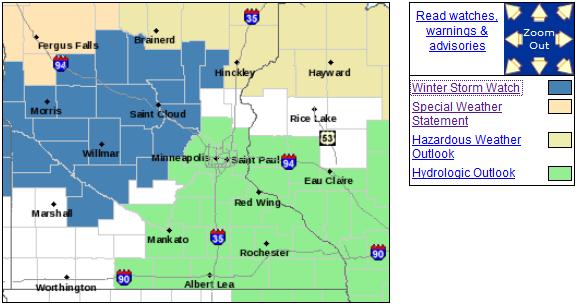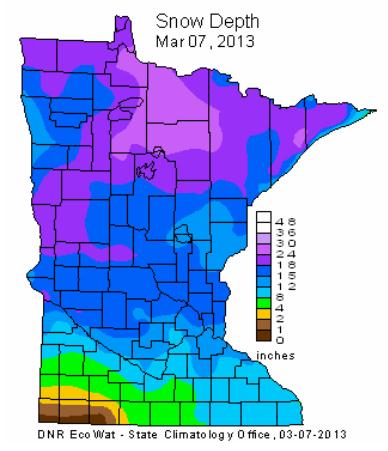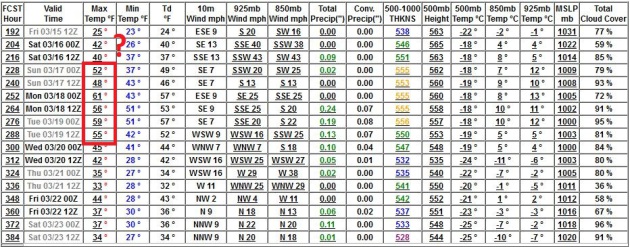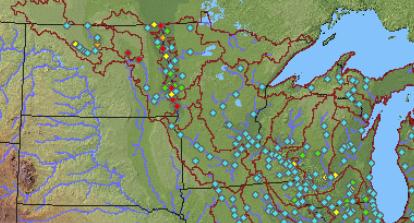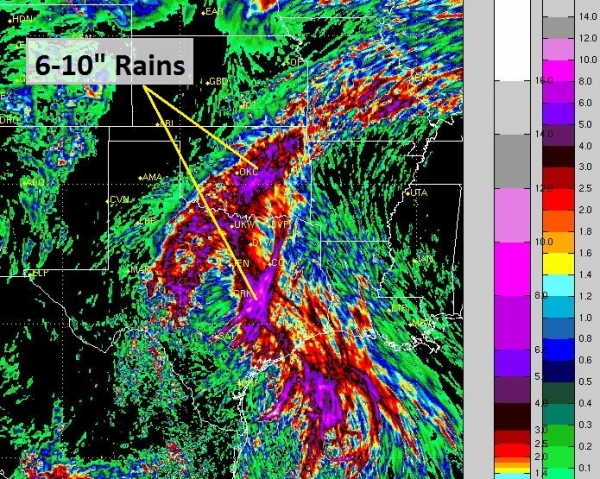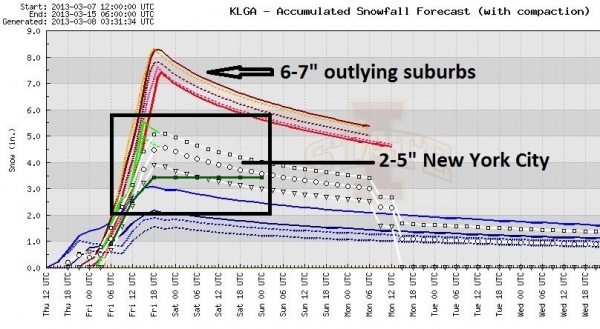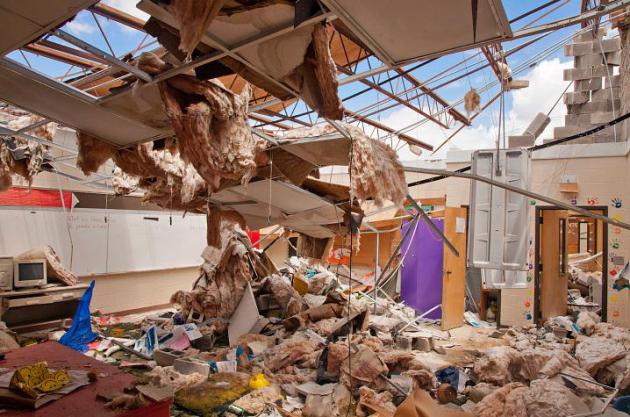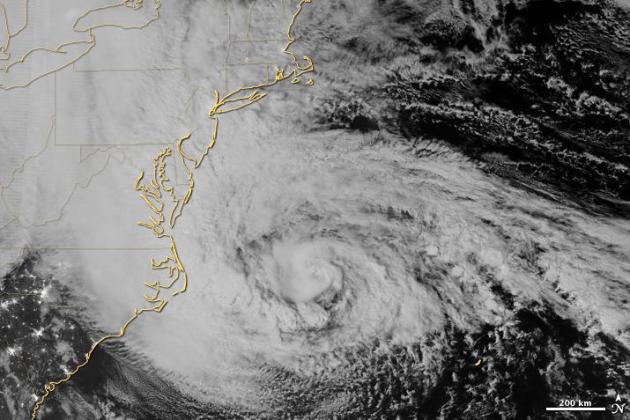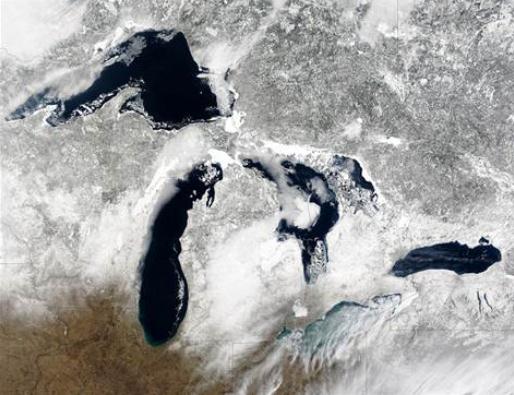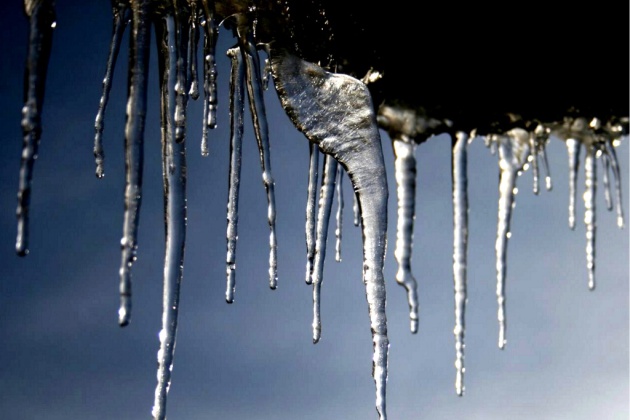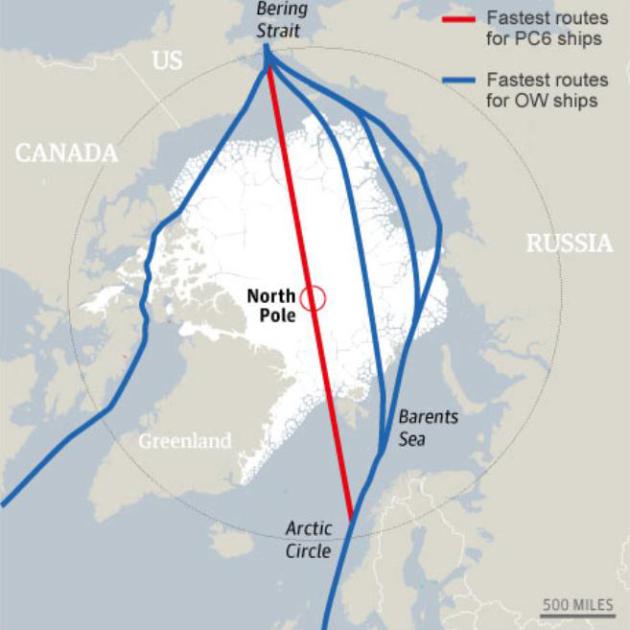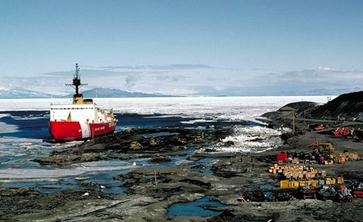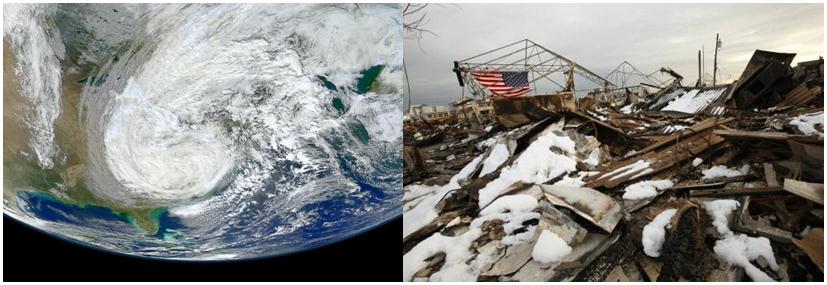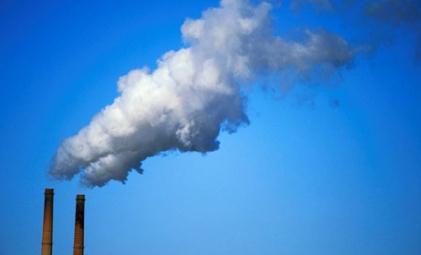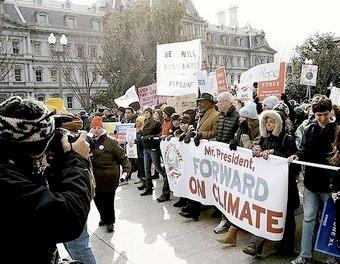Perception vs. Reality
Old Man Winter has a well-developed sense of
humor. Now that it's meteorological spring - most of Minnesota has the
most snow of the winter season on the ground. With 12 inches on the
ground, MSP has seen 45" so far, a little above average, to date.
There's 2 to 4 inches of liquid water trapped in that snow pack. The
drought is history, right? Sadly, looks can be deceiving.
The ground is frozen, to a depth of 20-40
inches. Until the frost leaves (late April?) all that melting snow won't
be able to replenish soil moisture. We have a lot of catching up to do.
State Climatologist Greg Spoden: "As of late
autumn the soil moisture content in the plant rooting zone was near an
all-time low level at many locations. Without abundant spring rains, a
number of critical drought issues involving agriculture, forestry,
horticulture, tourism and public water supply will begin to emerge."
Paradox: there's a high risk of moderate to major Red River flooding in the spring, in spite of a long-term drought.
Some hints of spring on the maps: rain Saturday
may end as a couple inches of slushy snow Saturday night and early
Sunday; 50F+ by the third week of March?
A word to the snow-wise: get out there sooner, rather than later, to play in the best snow of the winter.
Winter Storm Watch.
Although most of Saturday's precipitation will fall as rain in the Twin
Cities metro, it may begin as rain freezing on contact with cold
surfaces, and end as a few inches of slush over central and western
Minnesota. Details from NOAA:
...SIGNIFICANT ICING AND SNOWFALL POSSIBLE FRIDAY NIGHT THROUGH
SUNDAY MORNING OVER PORTIONS OF WEST CENTRAL AND CENTRAL
MINNESOTA...
.AN AREA OF LOW PRESSURE SHIFTING EAST FROM THE CENTRAL PLAINS
INTO THE MID MISSISSIPPI RIVER VALLEY FRIDAY NIGHT THROUGH SUNDAY
WILL SPREAD A MIX OF RAIN...FREEZING RAIN AND SNOW ACROSS WESTERN
AND CENTRAL PORTIONS OF MINNESOTA. THE PRECIPITATION WILL START
OUT AS A MIX OF FREEZING RAIN AND SNOW FRIDAY NIGHT THROUGH
SATURDAY MORNING...MIX WITH AND CHANGE OVER TO RAIN DURING THE DAY
ON SATURDAY...THEN MIX WITH AND CHANGE OVER TO LIGHT SNOW SATURDAY
EVENING AND CONTINUE THROUGH SUNDAY MORNING. ICE ACCUMULATION OF
ONE TENTH TO ONE QUARTER INCH ALONG WITH SNOWFALL TOTALS RANGING
FROM 3 TO 6 INCHES ARE POSSIBLE FRIDAY NIGHT THROUGH SUNDAY
MORNING. A WINTER STORM WATCH IS IN EFFECT FOR THOSE ALONG AND
WEST OF A LINE FROM MORA TO ELK RIVER TO HUTCHINSON TO REDWOOD
FALLS.
Nothing Better Than A Fine March Smog. From the
MPCA
(Minnesota Pollution Control Agency): "The MPCA has issued an air
pollution health advisory for the southern two-thirds of Minnesota,
including the Twin Cities metropolitan area and Rochester, effective
Friday, March 8th through midday Saturday, March 9th. Air quality
monitors indicate that fine particle pollution is increasing across the
southern two-thirds of the state. On Friday, early morning fog, high
pressure, and light southerly winds are expected to cause fine particle
pollution to be near a level considered unhealthy for sensitive groups.
These conditions are expected to persist until midday Saturday, when
increased wind speeds are expected to improve air quality conditions.
At-risk Populations: Fine
particle pollution is expected to be near a level considered unhealthy
for sensitive groups. Populations sensitive to find particles include
those with preexisting cardiovascular or respiratory disease, the
elderly, children, and individuals who participate in activities
requiring extended or heavy exertion, both indoors and outdoors. Members
of these groups are encouraged to postpone or reduce vigorous activity
and minimize exposure to local sources of air pollution (ie: heavy duty
vehicle traffic, wood fires, and candles). Even individuals who are
otherwise healthy may experience health effects when pollution levels
increase.
Health Impacts: Exposure to
high levels of fine particles has been linked with both respiratory and
cardiovascular health effects. Fine particles may exacerbate
pre-existing health conditions and may cause individuals to experience
chest pain, shortness of breath, wheezing, coughing or fatigue. If you
experience these symptoms contact your physician.
Climatology Update. Here's a highlight of the
latest update from Minnesota State Climatologist Greg Spoden:
- February average monthly temperatures in Minnesota were 2-4 F below
the historical average. For a number of communities it was only the
second time in 21 months that the mean monthly temperature was below
average.
- February precipitation totals were above historical averages
statewide. Monthly precipitation totals topped the historical average by
approximately one-half inch in many locations, and by over 1" in west
central and north central Minnesota counties.
- For most of the state, the water content of the
snow pack
is estimated to be 2-4 inches. Some west central , north central, and
northeast Minnesota counties report snow water equivalence values in
excess of 4".
- Because of solidly frozen topsoils and high snow water content in
west central Minnesota, the National Weather Service warns of a high
risk of moderate to major spring flooding along the Red River. This
could lead to an ironic paradox where most of the soil profile will
remain dry after floodwaters recede.
- The U.S. Drought Monitor continues to place large portions of
Minnesota in the Extreme Drought category. In total, 70% of Minnesota's
landscape is considered to be in Extreme Drought or Severe Drought. This
is down from 84% in late January. A one-category improvement was
assigned to some west central and north central Minnesota counties due
to heavy February snowfall.
- Despite the amount of water on the landscape, the drought situation
will likely remain unchanged until spring. The deeply and solidly
frozen soil assures that very little winter precipitation will make it
into the ground. As of late autumn, the soil moisture content in the
plant rooting zone was near an all-time low evel at many locations.
Without
abundant spring rains, a number of critical drought issues involving
agriculture, forestry, horticulture, tourism and public water supply
will begin to emerge.
More Hints of Spring? I'm not doing cartwheels just
yet, but the GFS brings 50s into the Twin Cities between March 17-20.
Snow on the ground will limit how mild it can get, but we may lose half
our snow cover if it rains as hard as I suspect it will on Saturday.
Flood Risk Increases With March Snowfall. Fargo's
INFORUM has more details on the snow pack over the Red River Valley impacting the (growing) risk of spring river flooding: "
Early
March snowfall has raised the risk of major flooding on the Red River,
the National Weather Service said today in its latest flood outlook.
In Fargo, the chances of the Red River topping major flood stage of 30
feet jumped from 79 percent to 88 percent since the last flood outlook
on Feb. 21. There’s a 50 percent chance the river will rise above 33.8
feet, up from a 50 percent chance at 33.2 feet in the Feb. 21 outlook.
The Red has a 5 percent chance of surpassing 38.2 feet, up from 37.8
feet in the last outlook. City officials say Fargo is well-protected to
38 feet without the need for sandbagging..."
Alerts Broadcaster Update on New England Storm:
* Snow wrapping around a Nor'easter, capable of 2-5" New York City,
as much as 6-8" eastern Long Island. It will be a rough Friday morning
commute, but roads should be mainly wet/slushy for drive home Friday PM.
* Boston will see considerably more snow; plowable amounts likely with as much as 5-10" (more western suburbs).
* Significant coastal flooding Friday for Massachusetts as sustained
winds reach 35-50 mph: beach erosion and inundation of highways within
7 feet of sea level.
Elevated risk of power outages over interior MA and Cape Cod, due to high winds coupled with high water content of snow.
Winter's Last Gasp? Maybe, but I'm not sure I'd
take that bet. Spring will come reluctantly this year over northern
states and New England, but the odds of major snowstorms will drop off
rapidly in the next 2 weeks. A white-knuckle commute is likely in New
York City Friday morning with some 2-5" amounts of slush, over 6-7"
farther east on the LIE over eastern Long Island. The heaviest snowfall
amounts will pile up over central and eastern Massachusetts; as much
as 5-10" in Boston (heaviest amounts western suburbs) - closer to
16-18" near Worcester. Model: WSI RPM.
New York City Slop-Storm. A period of light to
moderate wet snow lingers into the morning hours Friday, mixing with a
little rain at times. But 2-5" amounts of slush are possible before
precipitation tapers and mixes with rain. As much as 6-7" may fall from
coastal Connecticut to eastern Long Island. With a high sun angle most
roads will be wet for the PM commute Friday - getting home should be
easier. Graph: Iowa State.
Boston: More Snow, More Impacts. We still expect a
big east-west gradient in snowfall amounts in metro Boston; 4-5" at
Logan International to as much as 10" Newton and Waltham. Very
plowable.
High water content
in the snow combined with 30-45 mph winds will increase the potential
for power outages, especially 15-50 miles inland. Although not
as severe as the February 9 blizzard, this storm will impact travel
into midday Saturday in the Boston area, with some 1-2 foot snowfall
amounts possible south of Boston, closer to the Cape.
Tropical Storm Force Winds. The Nor'easter wrapping
up offshore is creating a sharp pressure gradient; winds accelerating
into this partial vacuum reaching 40-50 mph from Boston Harbor to Cape
Cod, sparking moderate to severe coastal flooding, beach erosion and
lowland inundation. Map: WSI RPM model.
Latest Warnings. A Winter Weather Advisory is
posted for metro New York, which sounds fairly trivial, but the Friday
AM commute will still be very slow in the 5 boroughs. Winter Storm
Warnings are in effect from Providence into much of Massachusetts for
heavier snowfall amounts. Coastal Flood Warnings are in effect Friday,
with the greatest impact on coastal Maine, New Hampshire and
Massachusetts. Details from NOAA:
...COASTAL FLOOD WARNING NOW IN EFFECT UNTIL 9 PM EST FRIDAY...
* LOCATION...MASSACHUSETTS EAST AND NORTHEAST FACING SHORELINES.
* COASTAL FLOODING...MINOR TO MODERATE FRIDAY EVENING... MORE
SERIOUS COASTAL FLOODING IS EXPECTED FOR FRIDAY MORNING/S HIGH
TIDE WITH MODERATE TO MAJOR IMPACTS LIKELY. MORE SPECIFICALLY
...MODERATE WITH POTENTIALLY AREAS OF MAJOR COASTAL FLOODING
IS EXPECTED FOR SALISBURY TO NEWBURY INCLUDING PLUM ISLAND...
AND HULL THROUGH SCITUATE AND PLYMOUTH TO SANDWICH. MODERATE
IMPACTS ARE EXPECTED ALONG THE NORTH SHORE...BOSTON HARBOR
AREA...AND NANTUCKET HARBOR. MINOR TO MODERATE COASTAL FLOODING
MAY OCCUR IN SPOTS ON MARTHA/S VINEYARD DURING FRIDAY MORNING.
* TIMING....730 AM TO 9 AM FRIDAY...AND 8 TO 9 PM FRIDAY EVENING.
THE GREATEST IMPACTS ARE EXPECTED DURING THE FRIDAY MORNING HIGH
TIDE...WHICH IS HIGHER ASTRONOMICALLY THAN THE EVENING HIGH
TIDES. FLOODING MAY PERSIST FOR MANY HOURS AFTER THE FRIDAY
MORNING HIGH TIDE IN LOW LYING AREAS DUE TO THE INABILITY TO
DRAIN BACK TO THE OCEAN.
* IMPACTS...THE FRIDAY MORNING HIGH TIDE HAS THE POTENTIAL TO
BE QUITE DANGEROUS AND COULD BE SIMILAR TO OR IN A FEW SPOTS
EVEN WORSE THAN THE FEBRUARY 9 STORM TIDE. SOME AREAS MAY BE
INUNDATED WITH 2 TO 4 FEET OF WATER...ESPECIALLY THOSE VULNERABLE
TO WAVE OVERWASH. LARGE WAVES MAY CAUSE SCATTERED DAMAGE TO
VULNERABLE STRUCTURES...AND SOME EVACUATIONS AS A PRECAUTION
MAY BE NECESSARY. SEVERE BEACH EROSION WILL CONTINUE THROUGH
FRIDAY MORNING. THE BEACH EROSION MAY BE ESPECIALLY SEVERE ALONG
THE OUTER CAPE...INCLUDING CHATHAM...AND ALONG THE EAST SIDE OF
NANTUCKET. SOME BEACH EROSION WILL LINGER INTO SATURDAY MORNING.
IF ASKED TO EVACUATE...PLEASE FOLLOW THE ADVICE OF LOCAL OFFICIALS
FOR YOUR OWN SAFETY AND THE SAFETY OF ANY WOULD BE RESCUERS.
Summary: The storm we've been tracking for 5 days
will drop a few inches of slush on metro New York, just enough to make
Friday travel interesting with double/triple normal commute times. Some
2-5" amounts are possible, with over 6" east of Plainview and
Levittown on Long Island. Some 5-10" amounts are likely in Boston, with
1 foot plus amounts over the far western/southern suburbs. Power
outages are likely Friday from Rhode Island into Massachusetts and
coastal New Hampshire. Beach erosion and coastal flooding will be most
severe over coastal Massachusetts. Winds ease Saturday as conditions
rapidly improve.
In A Warming World Storms May Be Fewer, But Stronger. Here's a clip of a story at
NASA's Earth Observatory: "...
Given
all the change that has already take place, it’s reasonable to wonder
if climate change has affected storms as well. “After the tornadoes in
2011, I was flooded with calls from reporters,” says Anthony Del Genio,
a climatologist at NASA’s Goddard Institute for Space Studies (GISS).
“People wanted quick, definitive answers. The trouble is that’s not
where the science is.” Historically, research on tornadoes, hurricanes,
and other types of storms has focused on short-term forecasting, not on
understanding how storms are changing over time. Reliable, long-term
records of storms are scarce, and the different reporting and observing
methods have left many scientists and meteorologists feeling
skeptical. But the study of storminess and climate has begun to mature,
says Del Genio, and a consensus is emerging: for several types of
storms, global warming may prime the atmosphere to produce fewer but
stronger storms..."
Photo credit above: "
Hackleburg High School in Alabama was destroyed by a tornado in April 2011." (
Photograph courtesy Federal Emergency Management Agency.)
Storm Aftermath Photos That Will Leave You Looking For Higher Ground.
Suddenly Minnesota's lakes look even more inviting. They freeze up in
winter, you can drive on them, but at least we don't have to worry about
towering storm surges. Here's an excerpt from
Wired: "
Mario Tama
spent more than his fair share of 2012 in a helicopter, surveying and
photographing the destruction of some of that year’s many powerful
storms. But it was on the ground where he felt the real impact, as he
photographed the people affected by these extreme meteorological
events. Like Melanie Martinez, a resident of Braithwaite, Louisiana, as
she looked through her flooded house after Hurricane Isaac. “There was
no specific plan to focus on climate change in 2012, as much of what
we do as photojournalists is reactive,” says Tama, a photojournalist
for Getty Images.
“But I suppose the evolution of the project was a natural progression
given the multitude of weather-related events of 2012 in this country.”
His edit of these photos, titled 2012 Climate Change: A New Normal in
America?, just won a Judge’s Special Recognition award in the Environmental Awareness Award category
at Picture of the Year International contest. Climate change is a
broad, diffuse subject, and it’s hard to illustrate it with photographs,
but Tama’s photos capture the sheer size of the destruction while also
humanizing the impacts..."
Photo credit above: "
A living room filled with sand washed in by Superstorm Sandy on Nov. 14, 2012 in Point Pleasant Beach, New Jersey."
Arctic Ice Loss Amplifed Superstorm Sandy Violence. Details in this post from
Cornell University: "...
The
researchers assert that the record-breaking sea ice loss from summer
2012, combined with the unusual atmospheric phenomena observed in late
October, appear to be linked to global warming. A strong atmospheric,
high-pressure blocking pattern over Greenland and the northwest
Atlantic prevented Hurricane Sandy from steering northeast and out to
sea like most October hurricanes and tropical storms from the
Caribbean. In fact, Sandy traveled up the Atlantic coast and turned
left "toward the most populated area along the eastern seaboard" and
converged with an extratropical cyclone; this, in turn, fed the
weakening Hurricane Sandy and transformed it into a monster tempest.
Superstorm Sandy's extremely low atmospheric pressure and the strong
high-pressure block to the north created violent east winds that pushed
storm surge against the eastern seaboard. "To literally top it off, the
storm surge combined with full-moon high tides and huge ocean waves to
produce record high water levels that exceeded the worst-case
predictions for parts of New York City," write the researchers." (Image above: NASA Earth Observatory).
Shrinking Ice Worries Great Lakes Scientists. Here's an excerpt of an article at
The News-Messenger: "..
.Ice
cover has decreased nearly 70 percent on the five Great Lakes since
the early 1970s, according to the National Oceanic and Atmospheric
Administration. The five Great Lakes hold 20 percent of the world’s
fresh water and have more than 11,000 miles of shoreline.
Every one of the lakes has endured the winter meltdown:
• Lake Ontario saw the most dramatic decrease with an 88 percent drop in ice coverage.
• Lake Superior lost 76 percent of its ice.
• Lake Michigan saw a decrease of 77 percent..."
Changes In Heart Attack Timing Continue Years After Hurricane. Major storms can influence the frequency and timing of heart attacks? Here's a segment of a story from
EurekAlert that made me do a double-take: ..."
The
stress and devastation brought on by Katrina doesn't just make a heart
attack more likely, but it also can alter when they occur," said
Matthew Peters, MD, a second year internal medicine resident at Tulane
University School of Medicine and the study's lead investigator. "It may
even outweigh or augment some of the physiological mechanisms [behind
heart attacks]." Heart attacks tend to be more common in the morning
and on weekdays, especially Mondays, because of surges in the body's
stress (cortisol) and "fight-or-flight" (catecholamines) hormones,
higher than normal blood pressure and heart rate, and a dip in the
body's ability to break up blood clots. But the shifts in behaviors and
routines seen after the storm may have trumped some of these factors,
Dr. Peters said..."
Climate Stories...
Study: In Just A Century, Globe Shifted From One Of The Coldest Decades In 11,000 Years To Warmest.
The Star Tribune has the story; here's an excerpt: "...
Research
released Thursday in the journal Science uses fossils of tiny marine
organisms to reconstruct global temperatures back to the end of the
last ice age. It shows how the globe for several thousands of years was
cooling until an unprecedented reversal in the 20th century. Scientists
say it is further evidence that modern-day global warming isn't
natural, but the result of rising carbon dioxide emissions that have
rapidly grown since the Industrial Revolution began roughly 250 years
ago. The decade of 1900 to 1910 was one of the coolest in the past
11,300 years — cooler than 95 percent of the other years, the marine
fossil data suggest. Yet 100 years later, the decade of 2000 to 2010
was one of the warmest, said study lead author Shaun Marcott of Oregon
State University. Global thermometer records only go back to 1880, and
those show the last decade was the hottest for this more recent time
period.
In 100 years, we've gone from the cold end of the
spectrum to the warm end of the spectrum," Marcott said. "We've never
seen something this rapid. Even in the ice age the global temperature
never changed this quickly...." (graphic credit
here).
* Andrew Revkin has more on this story at
The New York Times.
Ships To Sail Directly Over The North Pole By 2050, Scientists Say.
Well this is certainly great news! Who needs that polar ice anyway?
It's probably just there for show - it can't possibly serve a purpose in
nature, right? Here's an excerpt from
The Guardian: "
Ships
should be able to sail directly over the north pole by the middle of
this century, considerably reducing the costs of trade between Europe
and China but posing new economic, strategic and environmental
challenges for governments, according to scientists. The dramatic reduction in the thickness and extent of late summer sea ice
that has taken place in each of the last seven years has already made
it possible for some ice-strengthened ships to travel across the north
of Russia via the "northern sea route". Last year a total of 46 ships
made the trans-Arctic passage, mostly escorted at considerable cost by
Russian icebreakers. But by 2050, say Laurence C. Smith and Scott R.
Stephenson at the University of California in the journal PNAS on Monday,
ordinary vessels should be able to travel easily along the northern
sea route, and moderately ice-strengthened ships should be able to take
the shortest possible route between the Pacific and Atlantic Oceans,
passing over the pole itself. The easiest time would be in September,
when annual sea ice cover in the Arctic Ocean is at its lowest extent..."
Graphic credit above: "
Projected Arctic shipping routes." Photograph: guardian.co.uk
Climate Change Might Open Up Northwest Passage To Shipping By The Middle Of The Century. Here's an excerpt from
Scientific American: "
Investigating
what is sometimes seen as one of the more favorable effects of climate
change, a pair of scientists from UCLA has done a careful analysis
of the melting of Arctic sea ice and concluded that it could lead to
ships traversing the ice-free Northwest Passage (NWP) by 2050. It would
also lead to much shorter transit times through the existing North Sea
Passage (NSR). These developments may greatly reduce the time and cost
of shipping but would also lead to unforeseen economic and geopolitical
complications..."
Graphic credit above: "
Differences in transit routes for
two kinds of vessels (red and blue) enabled by shrinking Arctic ice
levels and opening of the Northwest Passage by 2050." (Image: Smith and Stephenson, PNAS, Early Edition)
Climate Change Will Open Up Surprising New Arctic Shipping Routes. The Washington Post has the story - here's an excerpt: "
Right
now, the Arctic Ocean is still too icy and treacherous for open-water
ships to traverse with any regularity. The Northwest Passage is only
navigable during the summer months once every seven years or so. Too
unreliable for commercial shipping. But that will soon change. As the
planet keeps warming, the Arctic’s summer sea ice is vanishing at a
stunning pace. That rapid melt is expected to have all sorts of sweeping impacts,
from speeding up climate change to wreaking havoc on weather patterns.
On the flip side, the loss of sea ice could also open up some
potentially lucrative new trade routes between the Atlantic and Pacific
Oceans."
An Inevitable Headline in 2014? CO2 Levels Pass 400 PPM For First Time In Human Existance. Here's the intro to a story at
scienceblogs.com: "
Sometime,
about one year from now, the front pages of whatever decent newspapers
are left will carry a headline like the one above, announcing that for
the first time in human existance (or in nearly a million years, or 3
million years, or 15 million years), the global atmospheric
concentration of carbon dioxide - the principal gas causing climate
change - will have passed 400 parts per million. That’s a significant
and shocking figure. Unfortunately, it is only a temporary marker on
the way to even higher and higher levels. Here (Figure 1 below) are the
most recent (March 2013) data from the Mauna Loa observatory showing
the inexorable increase in atmospheric CO2 and the rapid approach to 400
ppm..."
Graphic credit above: "
The concentration of CO2 in the
atmosphere measured by Scripps/NOAA at Mauna Loa. We’re rapidly
approaching 400 parts per million."
Most Insurers Lack A Plan To Address Climate Change, CERES Says.
Bloomberg has the story - here's a clip: "
Almost 90 percent of insurance companies lack a comprehensive plan to address climate change
and fewer than half of them view it as a likely source of financial
losses, according to a report released today. Only 23 of 184 insurers
surveyed demonstrated a “comprehensive climate change strategy” and 88
said they consider climate change a future loss driver, Boston-based Ceres
said today in a report. “Climate change exists, it’s happening, it’s
going to have an impact,” Mike Kreidler, Washington State insurance
commissioner, said in a phone interview. “It has the potential of being
a real game changer” for investments and underwriting..."
Climate Change And The U.S. Strategy. AOL Energy has an interesting story about the viability of a tax on carbon - here's a clip: "
At
a federal level, major regulation is not foreseeable in the near
future because it will not receive bipartisan support. However,
according to Dr. Joseph Aldy (Assistant Professor of Public Policy, Harvard Kennedy School), a carbon tax
policy project is more possible now than ever before. Dr. Gilbert
Metcalf (MIT's Joint Program on the Science and Policy of Global Change)
supported this view noting that fiscal problems faced by the US are
driving government to seriously consider a carbon tax that will generate
around $100 billion in revenue. Most of the regulation within the next
few years will probably be generated at a state level, where the new EPA director, Gina McCarthy, will closely work with states to create new approaches to tackle the climate change problem..."
Critical Part Of Keystone XL Report Done By Firms With Deep Oil Industry Tries.
Inside Climate News has the story; here's a clip: "
The State Department's recent conclusion
that the Keystone XL pipeline "is unlikely to have a substantial
impact" on the rate of Canada's oil sands development was based on
analysis provided by two consulting firms with ties to oil and pipeline
companies that could benefit from the proposed project. EnSys Energy has worked with ExxonMobil, BP and Koch Industries,
which own oil sands production facilities and refineries in the
Midwest that process heavy Canadian crude oil. Imperial Oil, one of
Canada's largest oil sands producers, is a subsidiary of Exxon..."
Kevin Trenberth: So What Should Be Done About Climate Change And The Vested Interests? Who
are the real radicals? Is it the people protesting the Keystone XL
Pipeline? Or is it the fossil fuel CEO's who are selling a product that
is altering the chemical composition of our atmosphere? Kevin Trenberth
is one of America's leading climate scientists; here's a portion of
his commentary related to a new documentary about climate denial ("Greedy Lying Bastards") which is being released this month: "...
This
is a global problem. It is an international problem. It involves not
just the environment, but also the economy, trade, foreign policy,
security, sustainability, and the human condition. It involves not
just the current peoples of the Earth but future generations. And many
small countries are powerless to influence their own fate. The huge
denial machine exposed by the documentary “Greedy Lying Bastards” is
very well funded by vested interests. Too many politicians in the
United States are bought and sold, and owned by their supporters for
their own selfish interests, and with nary a care about the well being
of the planet. This necessarily is a problem of the “tragedy of the
commons”. In this case the commons is the global atmosphere, shared by
all. The air over China one day resides over the United States five
days later, and then Europe five days after that. But the atmosphere
is a dumping ground for all sorts of pollution..."
Cherrypicking To Deny Continued Ocean and Global Warming.
As much as 90-93% of all the additional heat from greenhouse warming is
going into the oceans, specifically deep-ocean waters. Here's an
excerpt of an interesting post at
Skeptical Science: "...
Despite showing a larger ocean warming trend than Levitus, climate
contrarians likely prefer the Lyman data because it does not include
the ocean layers below 700 meters. However, even if we cherrypick this
shallow ocean data and cherrypick 2003 as the starting point, the 0–700
meter ocean heat accumulation for 2003–2012 in the Lyman PMEL data is equivalent to 1.2 Hiroshima atomic bomb detonations per second over the past decade.
For 1993–2012, this rate increases to the equivalent of 3.7
detonations per second, and when including global heat accumulation in
Nuccitelli et al. (2012) including the 0–2,000 meter oceans, the Earth
has accumulated the equivalent of 4 Hiroshima atomic bomb detonations
per second over the past decade. When we consider all the
available data, it becomes quite clear that ocean and global warming
continue unabated at a rapid rate. Cherrypicking cannot change that
reality..."
Graphic credit above: "
0–700 meter ocean heat content data from NOAA NODC (Levitus) and NOAA PMEL (Lyman) using the same baseline. The yellow arbitrary denialist line is shown, followed by the linear trends for 2003–2012 and 1993–2012 in red. Standard error bars are also shown."
Preaching On Climate Change.
Huffington Post has the story (and video clip); here's a segment: "...
I
truly do believe that we baby boomers are in grave danger. No longer
do we have any chance of just passing out of existence in a mediocre
way. Rather, there is no escaping this fact: As a generation, we will
leave behind a legacy that will be talked about for centuries. That
legacy will irrevocably brand us as either the worst generation of all
time or one of the greatest. It all depends on how we relate to our
mortality (the younger generations cannot afford to keep us alive as
long as technologically possible) and how we respond to the climate
chaos we are causing -- and that we can no longer deny or ignore. We
boomers are not only the generation in power now; we are also the
generation whose numbers (and previous decades of lavish consumption)
make us pointedly responsible for rising levels of carbon dioxide in the
atmosphere. "Richer than kings!" my wife and I regularly remind
ourselves whenever we enjoy a fresh avocado in Colorado in winter, when
we take a hot shower at the mere turn of a tap, when we receive quality
dental care, when we listen to music or audiobooks on our iPods, when
we never go hungry. But what kind of a world and life prospects will we
bequeath to our grandchildren?"

